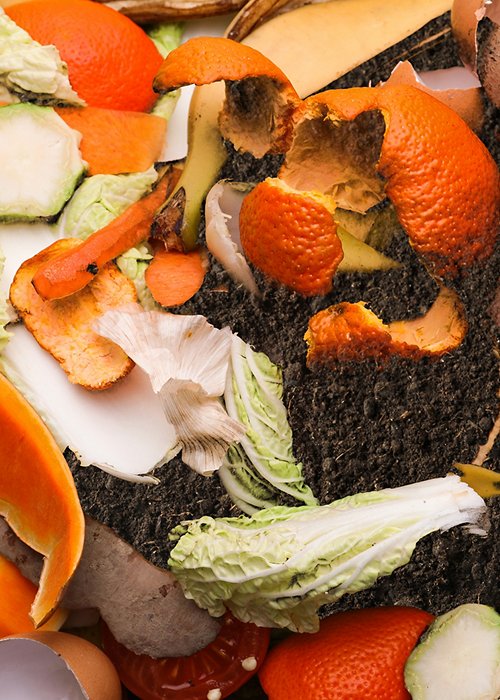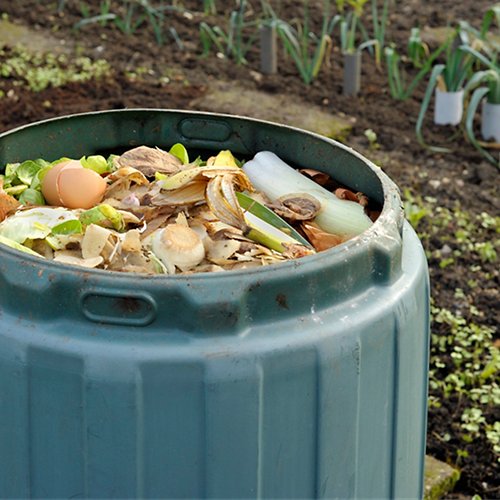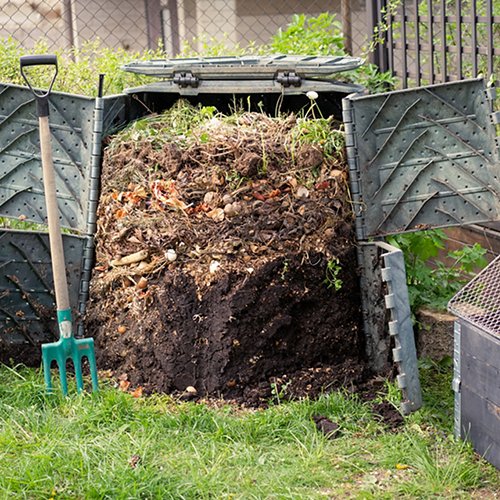Once upon a time there was an orange peel floating in the plate of leftovers from dinner and standing out for its vivid orange colour. But there was also some cauliflower, a piece of cheese with a green rind and some salad. And also that morsel of meat and that handful of rice that was just too much to swallow. Some would also call this waste, as well as leftovers, because left there on the plate it can only hope to be thrown in the rubbish bin and sent to a landfill, together with so many other things that were once useful. Once or still? And what if instead of waste these leftovers constitute a new resource? Surely that peel must have another use? Obviously there is an alternative: the orange peel and all our organic waste can become compost!
Voice search

Let's compost properly!
From peel to compost
The word compost is an English word, which comes from the Latin compositus via the French composte and which means “composite, variegated”. This is because compost originates from many different things that, once transformed, give rise to compost. But let’s take things one at a time; first of all what is compost, what has the orange peel got to do with it? As we said before, the orange peel can have two destinies when it is on the leftovers plate: it can be treated as waste and discarded or it can be recycled with the other humid organic part of waste. By humid organic part of waste is meant anything that is biodegradable organic waste. Think of what happens to an orange peel or a banana skin after having eaten the fruit: if you do not throw them away and leave them for a couple of days, you will see that their appearance will change, they will turn black and begin to have a foul smell and eventually rot. If you were to wait many days you would see that they no longer exist but that have turned into soil. This natural decomposition process is the work of certain micro-organisms and is essential to maintain the natural cycles, since it allows waste to be transformed into new nutrients. The name of the modern process of transformation of our organic biodegradable waste into soil is composting and is an accelerated process of what happens in nature.
The soil obtained is called compost and is particularly valuable for several reasons. First of all, it can significantly reduce waste the produced without any further pollution, indeed turning it once more into a resource, just like in nature. About a third of our rubbish bin, in fact, is filled with the leftovers from our meals.
Moreover, if organic waste were not composted, it would probably be taken to the landfill, where it would contribute to the formation of leachate (liquid produced by the contact between waste and rain water, often containing pollutants originating in the landfills) and biogas. If not recycled, the biogas would disperse into the atmosphere and contribute to the greenhouse effect, since it is mainly constituted by methane, a potent greenhouse gas. In addition to environmental reasons, there are also economic reasons in favour of compost. By producing compost we create an excellent fertiliser for the soil with many useful nutrients, thanks to which it is possible to reduce the use of more polluting synthetic fertilisers; compost makes the soil more porous and soft, with a greater ability to retain water, and combats the onset of plant diseases and pests or the formation of mosses.
From the cost point of view, compared to an estimated €60-90 per tonne for composted waste, it costs twice as much for waste to be sent to the landfill or incinerated.
Now that we have seen how beneficial it is for the orange peel to become compost, let’s see in more detail how and with what compost is made.
How to make compost
To make a good compost requires three basic ingredients: our orange peel and other organic waste, micro-organisms that make the transformation and, finally, the right conditions for the micro-organisms to work best.
Let’s start from the raw material, the orange peels and the like. We said that to start the composting process we need to use the organic part of the waste, namely: kitchen leftovers (vegetables, fruit, bread, pasta, fish, meat, cheese, etc.), paper handkerchiefs, tea bags, coffee grounds, but also pruning waste, twigs, leaves, lawn clippings or dead flowers. Theoretically, the list could continue because everything that is biodegradable can be composted, but some materials are not suitable or require a very long time and can lead to foul smells and they should therefore be avoided (for example, the shells of clams or mussels, fruit stones and nut shells do not compost or do so in a very long time). You can also use wood, cork, eggshells, ash, sawdust and paper bags, but with some precautions that we will see in a moment.

Food waste in a compost bin.
Having collected the materials we observe that these can be humid or dry: if they are humid they have a high nitrogen (N) content, if they are dry they have a higher carbon (C) content. Kitchen waste is usually humid, while twigs, leaves or paper are drier. A correct ratio of N and C is essential for successful compost, because an excess of one or the other slows down the work of the micro-organisms too much. What use is carbon and nitrogen to the micro-organisms? Carbon provides energy, while nitrogen provides the “food” necessary to produce amino acids and proteins. The optimal C/N ratio is approx. 30, i.e. one part of nitrogen requires 30 parts of carbon. Most of our ingredients have an unbalanced ratio in favour of nitrogen and are moist, so it’s good to mix them with elements which are drier and therefore richer in carbon such as paper bags, handkerchiefs, etc. Another essential element for successful compost is oxygen, because the micro-organisms responsible for degradation of the waste are aerobic, i.e. they work only in the presence of oxygen. Both to ensure the oxygen, as well as to have a good mix of materials and therefore allow the micro-organisms to work best, it is good practice to frequently turn the heap of humid and dry waste. If in throwing our leftovers and our dry materials we were to create anaerobic conditions, i.e. the absence of oxygen, unwanted micro-organisms would come into action, which would not allow the correct transformation of the compost and would also cause foul smells due to the formation of methane and ammonia.
In addition to oxygen and the C/N ratio, a third key parameter for successful compost is humidity: the heap should be slightly moist, but not too much, i.e. it must not be wet. To understand if the humidity is correct just pick up a bit of compost being transformed: if it looks like mud and is compact it means it is too wet; if it crumbles and looks like dust it is too dry; if, on the other hand, it sticks to the hand a bit but breaks down just like soil, then it has the right level of humidity.
Finally, as we suffer if it gets too hot or too cold, also the micro-organisms require an ideal temperature and it is necessary to avoid that the heap is exposed to extremely cold conditions. The increase or decrease in temperature identifies the phases of the composting process. In the initial phase, called fermentation (or thermophilic) phase, the micro-organisms begin to work and bring the temperature of the heap first to 40-45°C then to 50-60°C. If the heap is warm and turning it it gives off heat, the micro-organisms are working well. Moreover, the high temperatures also sanitise the compost and prevent the proliferation of pathogenic germs or parasitic eggs. After a period of between 30 and 60 days, the temperature drops again to 40°C and enters the maturing phase, in which certain specialised fungi and bacteria help the micro-organisms to decompose the most resistant components of the materials. In the third phase of final decomposition, the almost ready heap of compost is visited by earthworms or other small macro invertebrates, which accelerate and conclude the process and whose presence is a sign of success!
How long does it take for my orange peel to become compost? The time varies depending on the method used (industrial or domestic composting), the place in which it is done, the materials introduced, etc., but, generally speaking, fresh compost is obtained after 2-4 months, ready compost is obtained after 6- 9 months and, finally, after 9-12 months the compost becomes mature, will weigh 50% less than the original waste and have a volume of 30-40% less.
Now that we know how composting takes place, which practical solutions exist to prevent our organic waste ending up in landfills? The solutions depend on our way of life: if we live in a house with a garden we are lucky and we can do domestic composting. If, on the other hand, we live in a condominium and do not have the possibility of using the garden, we can properly separate our organic waste and send it for industrial composting or join collective composting clubs which are becoming popular in Italy.
Domestic composting
If you have a house with a garden or vegetable garden, you can directly see how the composting process works and allow the orange peel to turn into compost. The first step is to carefully select the materials so that there is as much variety as possible and remembering the rules of the previous paragraph. Among the waste mentioned, particularly suitable are: fruit and vegetable leftovers (raw or cooked), tea bags and coffee grounds, remains of pot plants, paper napkins and bags, vegetable garden waste, foliage, hair, feathers, litter of small animals and ash. The following waste should be used in moderate amounts: fish, meat, cold cuts and sausages, bones, walnuts and hazelnuts in large quantities. The following must never be included: plastic, laminated or coated paper, fabrics (also using natural fibres since they are often treated and coloured), vacuum cleaner filters, oil and rubber.
Having collected suitable materials, it is good practice to chop or grind them to allow the micro-organisms to be more efficient in their work.
Now that your waste is ready you can choose whether to make a compost heap or use a compost bin.

example of compost bin highlighting the various layers of the heap and the composting process
The compost heap the simplest and most economical, but requires a green area of sufficient size. Normally, the different layers of material alternate between green and humid waste and dry waste; the layers are placed one on top of the other to form a triangular or square-based heap of suitable dimensions, between 100-150 cm, and 80-100 cm high, with the base made of dry and porous material. To regulate the infiltration of rain water it is preferable to make a pyramid or trapezium-shaped heap.
To avoid aesthetic and logistic, problems a more practical solution is to use a compost bin, i.e. a container of various shapes and sizes that facilitates the composting process. For a family of 4 we recommend the use of a compost bin with a capacity of approx. 400 litres. The most common and practical compost bins in Italy are plastic and vertical in the shape of a truncated cone or trapezium, but there are also horizontal compost bins in wood and steel. The base is constituted by a flat grid, to allow ventilation, which culminates in a cone at the centre, so that air can also easily reach the middle of the heap and it is easier to turn. On the base is the central body – i.e. the area where the composting process takes place – with two openings: an upper one for introducing the waste and a lower one for removing the mature compost. If you are particularly good at DIY and want to try your hand at building your own compost bin, you can find videos and websites on the internet that explain how to do it. In addition, many local authorities offer a discount on waste collection fees for residents recycling their own organic waste.
Now that we have chosen the technique that we want to use, all we have to do is follow the steps that we have seen in the paragraph on the formation of compost and… wait a few months to see the first results!
Industrial or collective composting
If we do not have a garden, we must not give up: we still have two options to produce our compost! For municipalities that envisage separate collection of organic waste, we must be careful to include the correct organic materials that we saw in the previous list, collecting it in biodegradable-compostable bags (such as paper or Mater-Bi bags) in specific perforated bins to allow the passage of air. The material is collected and taken to large industrial composting plants, where the composting process is carried out on a large scale, with large amounts of waste, using more complex machines and computerised systems for constant monitoring of the process parameters and reduction of transformation time to the minimum.
If your municipality has not yet introduced separate organic waste collection, don’t worry! You can look for or propose in your town a collective composting group, i.e. groups of citizens or businesses (such as restaurants or canteens) that independently organise themselves to promote composting of their waste. To be able to do so, it is necessary to have larger compost bins than normal or use electromechanical compost bins, with continuous turning and air supply to maintain and accelerate the aerobic process. Although collective composting is taking its first steps and is not fully regulated in Italy, in other European countries (such as France, England, Sweden) it is already a well-organised practice and many small towns or neighbourhoods have already adopted or are about to adopt it.
Where should I throw it? New compostable materials
Now we know exactly what can be composted and what can not, how the process and a compost bin works and the differences between domestic, industrial and collective composting. We are now nearly perfect masters of the secrets of composting.
But what should we do with those materials that are not or do not seem to be organic but are compostable? You might have perhaps gone to the supermarket with your parents and forgotten the reusable shopping bags; to remedy the problem, the cashier will have given you a plastic bag, but a bit different from the usual ones, lighter and semi-transparent, with a strange smell of undergrowth. That bag is made of a new and very special material, bioplastic, and it is fully compostable.
What is bioplastic and why is it compostable? Bioplastic is a type of plastic that is derived from raw materials of natural origin (usually corn, wheat, cellulose starch, etc.) and is biodegradable, i.e. it can be degraded by micro-organisms exactly like the organic part of waste; it can therefore be composted! The degradation time of these new plastics is a few months, compared To the hundreds of years required for plastic of petrochemical origin (if you want to find out more, read the special on marine pollution caused by plastic). Plastic bags of petrochemical origin are now prohibited in Italy, even though they are unfortunately still widespread.
Can you only produce bags using bioplastics? Fortunately not! Bioplastics are also suitable to be used for many other products such as disposable tableware, food containers, bottles, fibres, etc., even sanitary towels and nappies! A big saving for the environment if they were composted! The important thing is that before putting these products/materials in the organic waste, check for the presence of the CIC (Italian Composting Consortium) or equivalent logo certifying compostability or the declaration of conformity with the UNI EN 13432 standard.
We have reached the end of our short journey in the world of composting and now all that remains to be seen is what happens to our orange peels by putting into practice this new knowledge!
By Nadia Mirabella
Read also...


